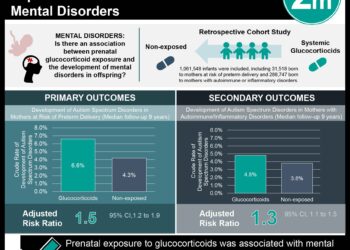No link between antenatal betamethasone and abnormal childhood bone development
There was no difference in bone mineral content, size and frequency of fractures in children who received repeated antenatal doses of glucocorticoids compared to those who received a single dose of glucocorticoids followed by repeat placebo doses.
Evidence Rating: 1 (Excellent)
Study Rundown: Premature neonates are at increased risk of respiratory distress syndrome due to surfactant deficiency and poor lung development. While antenatal glucocorticoids are the standard of care in promoting fetal lung maturation in preterm neonates, glucocorticoids may also play a role in accelerated bone loss. In the Australian Collaborative Trial of Repeat Doses of Corticosteroids (ACTORDS), researchers investigated whether repeated doses of antenatal corticosteroids altered bone mass, size and mineralization in school-aged children compared to those exposed to a single dose of antenatal corticosteroids followed by repeat doses of placebo. Their data demonstrated no significant differences in bone mass size or mineralization between groups. Additionally, there were no significant differences between groups for body segment proportions, spinal mineral content/area and fracture incidence. Children who received repeated doses of antenatal corticosteroids did, however, have a significant clinical reduction in markers of RDS. This study is limited by the use of completed whole-body dual-energy radiograph absorptiometry (DXA), which primarily reflects changes in cortical rather than trabecular bone. Additionally, no radiologic evidence of fractures was obtained for analysis of secondary outcomes. Overall, this study provides reassurance to providers who chose to administer repeated doses of antenatal corticosteroids to reduce symptoms of RDS.
Click to read the study, published today in Pediatrics
Relevant Reading: Antenatal corticosteroids for accelerating fetal lung maturation for women at risk of preterm birth.
Study Author, Dr. Chris McKinlay, PhD, talks to 2 Minute Medicine: Liggins Institute and Department of Paediatrics: Child and Youth Health, University of Auckland, Auckland, New Zealand.
“Repeat doses of antenatal glucocorticoids for preterm birth reduce neonatal morbidity but uptake of this treatment has been limited by concern about long-term adverse effects, including on skeletal development. In this randomised trial, exposure to repeat doses of antenatal betamethasone compared with a single course of antenatal glucocorticoids did not alter bone mass at 6 to 8 years’ corrected age, and is unlikely to increase the risk of later osteoporosis in offspring.”
In-Depth [randomized controlled trial]: In the original ACTORDS trial, pregnant women (N=982, 1146 live fetuses) with single to triplet pregnancy who had previously received antenatal glucocorticoids for ≥7 days and who were at risk of preterm delivery were randomized to receive further weekly treatments of either antenatal glucocorticoids or saline placebo if at continued risk of preterm delivery and <32 weeks’ gestation. The original study showed that infants exposed to repeat betamethasone compared to placebo had significant reductions in RDS. In this follow-up study, of 308 children were recruited, 185 completed DXA scans at 6-8 years corrected age. 91 were randomized to repeat antenatal betamethasone and 94 to placebo. The primary outcome was whole-body bone mineral content and area, while secondary outcomes included body segment proportions, spinal mineral content/area and fracture incidence. There were no significant differences in bone mineral content between repeat betamethasaone (median=553g; IQR=422-712) and placebo (median=567g; IQR=447-750) groups (geometric mean ratio=0.99; 95%CI=0.94-1.03, P=0.55). Additionally, there were no significant differences in secondary outcomes. In the repeat betamethasone and placebo groups, 12 (13%) and 10 (11%) of children experienced fractures (P=0.65).
Image: CC
©2017 2 Minute Medicine, Inc. All rights reserved. No works may be reproduced without expressed written consent from 2 Minute Medicine, Inc. Inquire about licensing here. No article should be construed as medical advice and is not intended as such by the authors or by 2 Minute Medicine, Inc.







